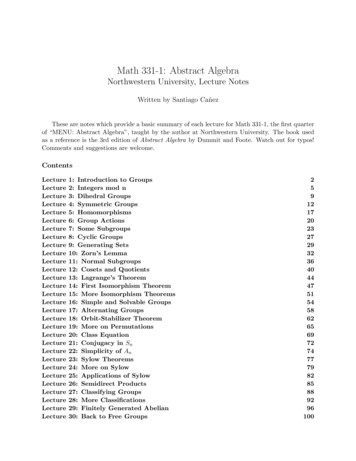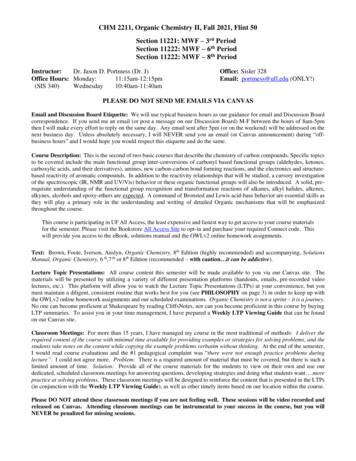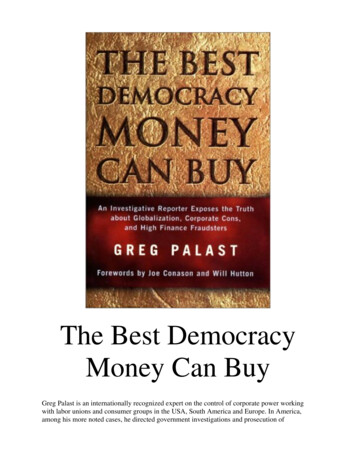
Transcription
Selected Solutions to Dummit and Foote’sAbstract Algebra Third EditionGreg KikolaJuly 16, 2020
iiCopyright 2019–2020 Greg Kikola.License CC BY-SA 4.0:Creative Commons Attribution-ShareAlike 4.0 International.This document lives at:https://www.gregkikola.com/projects/guides/You can find the LATEX source code on GitHub at:https://github.com/gkikola/sol-dummit-foote
ContentsPrefacev0 Preliminaries0.1 Basics . . . . . . . . . . . . . . . . . . . . . . . . . . . . . . . . .0.2 Properties of the Integers . . . . . . . . . . . . . . . . . . . . . .0.3 Z/nZ: The Integers Modulo n . . . . . . . . . . . . . . . . . . . .114111 Introduction to Groups1.1 Basic Axioms and Examples . . . .1.2 Dihedral Groups . . . . . . . . . .1.3 Symmetric Groups . . . . . . . . .1.4 Matrix Groups . . . . . . . . . . .1.5 The Quaternion Group . . . . . . .1.6 Homomorphisms and Isomorphisms1.7 Group Actions . . . . . . . . . . .1717323846525465.2 Subgroups2.1 Definition and Examples . . . . . . . . . . . .2.2 Centralizers and Normalizers . . . . . . . . .2.3 Cyclic Groups and Cyclic Subgroups . . . . .2.4 Subgroups Generated by Subsets of a Group .2.5 The Lattice of Subgroups of a Group . . . . .75. 75. 83. 91. 102. 1103 Quotient Groups and Homomorphisms3.1 Definitions and Examples . . . . . . . . . .3.2 More on Cosets and Lagrange’s Theorem .3.3 The Isomorphism Theorems . . . . . . . . .3.4 Composition Series and the Hölder Program3.5 Transpositions and the Alternating Group .123123150161168175A Cartesian Products and Zorn’s Lemma183A.1 Cartesian Products . . . . . . . . . . . . . . . . . . . . . . . . . . 183A.2 Partially Ordered Sets and Zorn’s Lemma . . . . . . . . . . . . . 184iii
ivCONTENTS
PrefaceThis is an unofficial solution guide to the book Abstract Algebra, Third Edition,by David S. Dummit and Richard M. Foote. It is intended for students who arestudying algebra with Dummit and Foote’s text. I encourage students who usethis guide to first attempt each exercise for themselves before looking up thesolution, as doing exercises is an essential part of learning mathematics.In writing this guide, I have avoided using techniques or results before thepoint at which they are introduced in the text. My solutions should thereforebe accessible to someone who is reading through Dummit and Foote for the firsttime.Given the large number of exercises, errors are unavoidable in a work suchas this. I have done my best to proofread each solution, but mistakes will makeit through nonetheless. If you find one, please feel free to tell me about it in anemail: gkikola@gmail.com. I appreciate any corrections or feedback.Please know that this guide is currently unfinished. I am slowly working onadding the remaining chapters, but this will be done at my own pace. If youneed a solution to an exercise that I have not included, try typing the problemstatement into a web search engine such as Google; it is likely that someone elsehas already posted a solution.This guide is licensed under the Creative Commons Attribution-ShareAlike4.0 International License. To view a copy of this license, /I am deeply grateful to the authors, David S. Dummit and Richard M. Foote,for producing a wonderfully comprehensive and thoroughly well-written work. Ialso owe particular thanks to those readers who have taken the time to contactme in order to point out mistakes or to give general feedback.Greg Kikolawww.gregkikola.comgkikola@gmail.comv
viPREFACE
Chapter 0Preliminaries0.1BasicsLet A be the set of 2 2 matrices over R, 1M 0let 1,1and letB {X A M X XM }.0.1.1Exercise 1Determine which of the following elements of A lie in 1 11 10 01 11,,,,0 11 10 01 00Solution. It is easy to verify that 1 10,0 10 0,0 and10B: 00,11 1.0 01all commute with M : the first matrix is M itself, and the latter two are thezero matrix and the identity matrix, all of which will commute. So each of thesematrices is in B.We can check the remaining matrices individually: Let 1 11 10 1P , Q , and R .1 11 01 0Direct computation shows that 2MP 1 2MQ 1and 1MR 1So P, Q, R 6 B.21 1 2 P M,1 2 11 26 QM,01 110 6 06 1111 RM.
20.1.2CHAPTER 0. PRELIMINARIESExercise 2Prove that if P, Q B, then P Q B.Proof. Let aP c bd and Q egfh be matrices in the set B, so that M P P M and M Q QM . Then we have 1 1a e b fM (P Q) 0 1c g d h a e c g b f d h c gd h a c b de g f h cdgh MP MQ P M QM a a be e f c c dg g h a e a b e f c g c d g h a e b f1 1 c g d h0 1 (P Q)M.Therefore P Q B.0.1.3Exercise 3Prove that if P, Q B, then P Q B.Proof. A similar argument to the one in Exercise 2 above will show that P Q Bfor any P, Q B.0.1.4Exercise 4 Find conditions on p, q, r, s which determine precisely whenSolution. Let Then MP while10 PM prP pr 1p1rqsqs 10 q.s 11 p r r p r q ss p q.r sprqs B.
0.1. BASICS3Therefore, M P P M if and only if r 0 and p s. Hence p p qB p, q R .0p0.1.5Exercise 5Determine whether the following functions f are well defined:(a) f : Q Z defined by f (a/b) a.(b) f : Q Q defined by f (a/b) a2 /b2 .Solution.(a) f is not well defined since, for example,f (1/2) 1,f (2/4) 2,but12 .24(b) Suppose a, b, c, d Z with b, d 6 0 are such thatca .bdThen a 2 c 2c2a2 2 f (c/d). 2bbddTherefore f is well defined.f (a/b) 0.1.6Exercise 6Determine whether the function f : R Z defined by mapping a real numberr to the first digit to the right of the decimal point in a decimal expansion of ris well defined.Solution. f is not well defined since decimal expansions are not unique. Forexample, 1 1.0 0.999 . . . but f (1.0) 0 and f (0.999 . . .) 9.0.1.7Exercise 7Let f : A B be a surjective map of sets. Prove that the relationa b if and only if f (a) f (b)is an equivalence relation whose equivalence classes are the fibers of f .Proof. That is an equivalence relation on A follows directly from the fact that is an equivalence relation on the set B.Now let b B be arbitrary. Since f is surjective, there is an a in A suchthat f (a) b. Then the equivalence class of a is the set{x A x a}.But by definition of , this set is equal to{x A f (x) f (a) b}.Therefore the equivalence class of a is precisely the fiber of f over b.
4CHAPTER 0. PRELIMINARIES0.2Properties of the Integers0.2.1Exercise 1For each of the following pairs of integers a and b, determine their greatestcommon divisor, their least common multiple, and write their greatest commondivisor in the form ax by for some integers x and y.(a) a 20, b 13.Solution. Applying the Division Algorithm repeatedly, we get20 1(13) 713 1(7) 67 1(6) 16 6(1) 0.The first nonzero remainder is 1, so (20, 13) 1. That is, the two numbersare relatively prime.The least common multiple, [20, 13], is given by20 · 13 260.(20, 13)To write 1 as a linear combination of 20 and 13, we work backwards andsubstitute:1 7 1(6) 7 1(13 1(7))(Substituting 6 13 7) 2(7) 1(13) 2(20 1(13)) 1(13)(Substituting 7 20 13) 2(20) 3(13).(b) a 69, b 372.Solution. As above, we have372 5(69) 2769 2(27) 1527 1(15) 1215 1(12) 312 4(3) 0,so (69, 372) 3, which gives [69, 372] 8556. And again, as before, we
0.2. PROPERTIES OF THE INTEGERS5write3 15 1(12) 15 1(27 1(15))(Substituting 12 27 15) 2(15) 1(27) 2(69 2(27)) 1(27)(Substituting 15 69 2(27)) 2(69) 5(27) 2(69) 5(372 5(69))(Substituting 27 372 5(69)) 27(69) 5(372).(c) a 792, b 275.Solution.792 2(275) 242275 1(242) 33242 7(33) 1133 3(11) 0.Hence (792, 275) 11. Calculating the least common multiple gives[792, 275] 19 800. Then11 242 7(33) 242 7(275 242) 8(242) 7(275) 8(792 2(275)) 7(275) 8(792) 23(275).(d) a 11 391, b 5673.Solution. Using the methods above, we get(11 391, 5673) 3,[11 391, 5673] 21 540 381and 126(11 391) 253(5673) 3.(e) a 1761, b 1567.Solution.(1761, 1567) 1,[1761, 1567] 2 759 487,and 105(1761) 118(1567) 1.
6CHAPTER 0. PRELIMINARIES(f) a 507885, b 60808.Solution.(507885, 60808) 691,[507885, 60808] 44 693 880,and 17(507885) 142(60808) 691.0.2.2Exercise 2Prove that if the integer k divides the integers a and b then k divides as btfor every pair of integers s and t.Proof. Suppose a and b are such that k a and k b. By definition, this meansthat there exists integers m and n such that a mk and b nk. Therefore, forany integers s and t,as bt (mk)s (nk)t (ms nt)k.Since ms nt must be an integer (due to closure of integer addition and multiplication), this shows that k (as bt).0.2.3Exercise 3Prove that if n is composite then there are integers a and b such that n dividesab but n does not divide either a or b.Proof. The Fundamental Theorem of Arithmetic guarantees that n is the product of two or more (possibly equal) prime factors. Let a be one of the primefactors, and let b be n/a. Note that b must be an integer since a n. Note alsothat a, b 1.Now n ab, so clearly n ab. However, n - a since a is prime and n iscomposite.Finally, suppose for contradiction that n b. Then there is an integer k 1such that b kn. Multiplying by a on both sides gives ab akn or n akn.Dividing by n then gives ak 1. But this is absurd because a and k are bothintegers greater than 1. This contradiction shows that n - b, so the proof iscomplete.0.2.4Exercise 4Let a, b, and N be fixed integers with a and b nonzero and let d (a, b) be thegreatest common divisor of a and b. Suppose x0 and y0 are particular solutionsto ax by N (i.e., ax0 by0 N ). Prove for any integer t that the integersbax x0 t and y y0 tddare also solutions to ax by N .(1)
0.2. PROPERTIES OF THE INTEGERS7Proof. Substituting for x and y in ax by gives ba ababa x0 t x b y0 t (ax0 by0 ) t tdddd ax0 by0 N.This holds regardless of the value of t, so (1) is always a valid solution.0.2.5Exercise 5Determine the value ϕ(n) for each integer n 30 where ϕ denotes the Eulerϕ-function.Solution. For each n, the value of ϕ(n) can be determined by first finding theprime factorization of n,αk1 α2n pα1 p2 · · · pk ,where each pi is prime,and then by applying the formula given in the text:1 1ϕ(n) pα(p1 1)p2α2 1 (p2 1) · · · pkαk 1 (pk 1).1For example, to find ϕ(18), we factor 18 2 · 32 . Applying the formula thengivesϕ(18) 21 1 (2 1) · 32 1 (3 1) 1·1·3·2 6.Applying this process to each n 30 produces the following 20261227182812308This process can be used to easily find ϕ(n) for any n whose prime factorization is known.0.2.6Exercise 6Prove the Well Ordering Property of Z by induction and prove the minimalelement is unique:Theorem. If A is any nonempty subset of Z , there is some element m Asuch that m a, for all a A.
8CHAPTER 0. PRELIMINARIESProof. Suppose for contradiction that A has no minimal element. We will proveby (strong) induction on n that for each n Z , n 6 A. This will show that Ais the empty set, which would contradict the requirement that A be nonempty.Clearly 1 6 A, for otherwise 1 would be a least element (since 1 a for alla Z ). Now suppose that 1, 2, . . . , k 6 A for some positive integer k. Thenk 1 cannot be a member of A since otherwise k 1 would be the minimalelement. This completes the inductive step, which shows that A is the emptyset, giving the needed contradiction to show that A has a minimal element.Finally, to show that the minimal element is unique, suppose A has twominimal elements, a and b. Since a is minimal, a b. But b is minimal, sob a. So a b and a b and therefore a b.0.2.7Exercise 7If p is a prime prove that there do not exist nonzero integers a and b such that a2 pb2 (i.e., p is not a rational number).Proof. Suppose for contradiction that a and b are nonzero integers witha2 pb2 .Without loss of generality we may also assume that a and b have no factors incommon (if they do have factors in common, just divide the factors from bothsides of the equation).Now p a2 . And since p is prime, we must also have p a (this uses the“important property” mentioned in item (8) on page 6 of the text). Then thereis an integer m such that a pm and hence (pm)2 pb2 , or p2 m2 pb2 . Thisimplies that pm2 b2 so that p b2 , which implies p b. But a and b werechosen to have no factors in common, yet p is a common factor. This gives theneeded contradiction.0.2.8Exercise 8Let p be a prime, n Z . Find a formula for the largest power of p whichdivides n! n(n 1)(n 2) · · · 2 · 1.Solution. The only integers less than n that are divisible by p are the multiplesof p, of which there are npof them, where bxc denotes the floor of x (i.e., the greatest integer less than orequal to x).However, multiples of p2 each contribute a second factor of p. Multiples of3p contribute a third additional factor of p, and so on. Therefore the highestpower of p that divides n! is given byblogp nc Xnnnn 2 3 ··· .ppppkk 1
0.2. PROPERTIES OF THE INTEGERS0.2.109Exercise 10Prove for any given positive integer N there exist only finitely many integersn with ϕ(n) N where ϕ denotes Euler’s ϕ-function. Conclude in particularthat ϕ(n) tends to infinity as n tends to infinity.Solution. Fix a value of N 0, and let A be the set of all solutions n to theequation ϕ(n) N . We must show that A is a finite set.First we will show that for any n A, there cannot be a prime factor of nlarger than N 1. For if there are prime factors larger than N 1, then wemay choose the smallest such prime p. Then if q is any prime factor of n withq p, we may write n q k r, where r is some positive integer relatively primeto q. Therefore we haveϕ(n) ϕ(q k )ϕ(r) q k 1 (q 1)ϕ(r) q 1 N.But ϕ(n) N , so this is a contradiction. This shows that all prime factors ofn must be at most N 1.Now let p1 , p2 , . . . , pm be all the prime factors less than or equal to N 1(note that this set of primes is finite). Then every n A can be written in theformαm2n p1α1 pα2 · · · pm ,where each αi 0 and αj 0 for at least one index j. Now observe that eachαi can be one of only finitely many possible values, since ϕ(psi ) psi (pi 1) Nifor sufficiently large values of s, and N is the product of each ϕ(pαi ). So thedistinct values of n in A must be finite in number, because there are only finitelymany possible primes in their prime factorizations and their exponents can takeonly finitely many possible values.Finally, let M be any positive integer. Since there are only finitely manyvalues of n such that ϕ(n) M , we may choose the largest such n. Thenϕ(m) M for all m n, which shows that ϕ(n) tends to infinity as n tends toinfinity.0.2.11Exercise 11Prove that if d divides n then ϕ(d) divides ϕ(n) where ϕ denotes Euler’s ϕfunction.Solution. First consider the case where n pk for some prime number p. Thenif d n we must have d p for some integer with 0 k. Soϕ(n) ϕ(pk ) pk 1 (p 1)and ϕ(d) ϕ(p ) p 1 (p 1).Now let a pk . Then aϕ(d) ϕ(n), so ϕ(d) ϕ(n).The more general case will follow from the fact that ϕ is a multiplicativefunction: Let n be a positive integer having prime factorizationαk2n p1α1 pα2 · · · pk ,
10CHAPTER 0. PRELIMINARIESand suppose d is an integer that divides n. Then d can be written as a product of these same prime factors p1 , . . . , pk , provided that we allow some of theexponents to be zero. That is, we may writed pβ1 1 pβ2 2 · · · pβkkwith 0 βi αi for each i.Thenαkα21ϕ(n) ϕ(pα1 )ϕ(p2 ) · · · ϕ(pk )(2)ϕ(d) ϕ(pβ1 1 )ϕ(pβ2 2 ) · · · ϕ(pβkk ).(3)andpβi iipαi ,so from the argument in the first paragraph, we knowdividesNow eachi)foreachi. Therefore we may find an integer ai such thatthat ϕ(pβi i ) ϕ(pαiβii).Therefore,equations (2) and (3) imply that) aϕ(pϕ(pαiiiϕ(n) a1 ϕ(pβ1 1 ) · a2 ϕ(pβ2 2 ) · · · ak ϕ(pβkk ) (a1 a2 · · · ak )ϕ(d),so ϕ(d) ϕ(n).
0.3. Z/N Z: THE INTEGERS MODULO N0.30.3.111Z/nZ: The Integers Modulo nExercise 1Write down explicitly all the elements in the residue classes of Z/18Z.Solution. The residue classes are0̄ {0, 18, 18, 36, 36, . . .},1̄ {1, 19, 17, 37, 35, . . .},2̄ {2, 20, 16, 38, 34, . . .},3̄ {3, 21, 15, 39, 33, . . .},4̄ {4, 22, 14, 40, 32, . . .},5̄ {5, 23, 13, 41, 31, . . .},6̄ {6, 24, 12, 42, 30, . . .},7̄ {7, 25, 11, 43, 29, . . .},8̄ {8, 26, 10, 44, 28, . . .},9̄ {9, 27, 9, 45, 27, . . .},10 {10, 28, 8, 46, 26, . . .},11 {11, 29, 7, 47, 25, . . .},12 {12, 30, 6, 48, 24, . . .},13 {13, 31, 5, 49, 23, . . .},14 {14, 32, 4, 50, 22, . . .},15 {15, 33, 3, 51, 21, . . .},16 {16, 34, 2, 52, 20, . . .},and17 {17, 35, 1, 53, 19, . . .}.0.3.2Exercise 2Prove that the distinct equivalence classes in Z/nZ are precisely 0̄, 1̄, 2̄, . . . , n 1(use the Division Algorithm).Proof. Consider the equivalence class k̄. Using the Division Algorithm, we mayfind an integer q and an integer r such thatk qn r,with 0 r n.Now k r (mod n) and r is an integer between 0 and n 1, so this shows that 1}.k̄ r̄. Thus the equivalence classes in Z/nZ are a subset of {0̄, 1̄, . . . , n Finally, we note that the equivalence classes 0̄, . . . , n 1 are actually distinctfrom each other. For, if not, suppose ā b̄ where 0 b a n 1. Thenn (a b), and since 0 a b n 1, we must have a b 0 so that a b.Therefore the distinct equivalence classes are precisely 0̄, . . . , n 1.
120.3.3CHAPTER 0. PRELIMINARIESExercise 3Prove that if a an 10n an 1 10n 1 · · · a1 10 a0 is any positive integerthen a an an 1 · · · a1 a0 (mod 9) (note that this is the usual arithmeticrule that the remainder after division by 9 is the same as the sum of the decimaldigits mod 9 – in particular an integer is divisible by 9 if and only if the sum ofits digits is divisible by 9).Solution. Let a be as stated. Since 10 1 (mod 9) we may apply Theorem 3to writea an 1n an 1 1n 1 · · · a1 a0 an an 1 · · · a1 a00.3.4(mod 9)(mod 9).Exercise 4Compute the remainder when 37100 is divided by 29.Solution. 372 1369 6 (mod 29). Successive squaring then yields374 62 36 78(mod 29)237 7 49 203716373237642(mod 29) 20 400 232 23 529 72 7 49 20(mod 29)(mod 29)(mod 29).So37100 3764 3732 374 20 · 7 · 7 23Therefore 370.3.5100(mod 29).has a remainder of 23 when divided by 29.Exercise 5Compute the last two digits of 91500 .Solution. 91500 33000 271000 . Now 272 729 29 (mod 100), and successive squaring then gives274 292 841 41(mod 100),82(mod 100),27162(mod 100),27322(mod 100),276427 41 1681 81 81 6561 61 61 3721 212 21 441 41(mod 100).At this point the numbers start to repeat, so that 27128 81 (mod 100), 27256 61 (mod 100), and 27512 21 (mod 100). Therefore91500 271000 27512 27256 27128 2764 2732 278 21 · 61 · 81 · 41 · 21 · 81 (1281)(3321)(1701) 81 · 21 · 1 1(mod 100).Therefore, the last two digits of 91500 are 01.
0.3. Z/N Z: THE INTEGERS MODULO N0.3.613Exercise 6Prove that the squares of the elements in Z/4Z are just 0̄ and 1̄.Proof.02 0 021 1 1(mod 4),22 4 0(mod 4),23 9 10.3.7(mod 4),(mod 4).Exercise 7Prove for any integers a and b that a2 b2 never leaves a remainder of 3 whendivided by 4 (use the previous exercise).Proof. a2 and b2 are each either congruent to 0 or to 1, modulo 4. Addinga2 b2 then gives four cases:0 0 0(mod 4),0 1 1(mod 4),1 0 1(mod 4),1 1 2(mod 4).In every case, a2 b2 never has a remainder of 3 when divided by 4.0.3.8Exercise 8Prove that the equationa2 b2 3c2(4)has no solutions in nonzero integers a, b, and c.Proof. Consider the equation modulo 4. From the previous exercise, the lefthand side cannot be congruent to 3. However, the right-hand side is congruentto either 0 or 3, so therefore both sides must be congruent to 0. That is,a2 b2 c2 0(mod 4).This immediately implies that c is even. Now, if a is even, then b must beeven, since b2 c2 a2 is even. On the other hand, if a is odd, then b must beodd for the same reason. But if a and b are both odd, then we may find integersm and n such thata2 b2 (2m 1)2 (2n 1)2 4m2 4m 1 4n2 4n 1 2(mod 4).This is impossible, so a, b, and c must all be even.
14CHAPTER 0. PRELIMINARIESNow, if possible, suppose that a, b, and c are three positive integers whichsatisfy the equation (4). Since all three integers must be even, their squareseach contain a factor of 4. Divide both sides by 4 to get a new equation,α2 β 2 γ 2 ,where α a, β b, and γ c.But by the same argument as before, α, β, and γ must be even, so theirsquares are divisible by 4 and we can again find an even smaller set of solutions.This process could be repeated indefinitely, to get smaller and smaller positiveinteger solutions. Clearly this is not possible, so there are no solutions in thenonzero integers.0.3.9Exercise 9Prove that the square of any odd integer always leaves a remainder of 1 whendivided by 8.Proof. If a is an odd integer, then a can be written as 2k 1 for some integerk, anda2 (2k 1)2 4k 2 4k 1 4k(k 1) 1.Now k(k 1) must be even, since it is the product of consecutive integers.Therefore 4k(k 1) is divisible by 8. Therefore a2 1 (mod 8).0.3.10Exercise 10Prove that the number of elements of (Z/nZ) is ϕ(n) where ϕ denotes theEuler ϕ-function.Proof. We will show that the elements in (Z/nZ) are precisely those residueclasses whose representatives are relatively prime to n.First suppose that a (Z/nZ) and let b be the multiplicative inverse of amodulo n, so that ab 1 (mod n). Then n (ab 1) so we may find an integerm such that mn ab 1. Rearranging, we get ab mn 1. But this showsthat the greatest common divisor of a and n is 1 (if not, we could factor theleft-hand side to get a product of two integers, not both 1, that equals 1, whichis impossible). Therefore any number in (Z/nZ) must be relatively prime ton.Now, for the other direction, suppose that a is any integer relatively primeto n. Then we can use the Euclidean algorithm to write the common divisor 1as a linear combination of a and n, that is,ax ny 1,x, y Z.But then ax 1 (mod n), so x is the multiplicative inverse of a modulo n, i.e.,a (Z/nZ) .Since there are exactly ϕ(n) least residues which are coprime to n, the set(Z/nZ) has exactly ϕ(n) elements.
0.3. Z/N Z: THE INTEGERS MODULO N0.3.1115Exercise 11Prove that if ā, b̄ (Z/nZ) , then ā · b̄ (Z/nZ) .Proof. Let ā and b̄ be in (Z/nZ) as stated. Then ā has a multiplicative inversex̄ and b̄ has an inverse ȳ. Then(āx̄)(b̄ȳ) 1 · 1 1(mod n).Rearranging the left-hand side, we see that x̄ȳ is the multiplicative inverse ofāb̄, so that āb̄ (Z/nZ) .0.3.12Exercise 12Let n Z, n 1, and let a Z with 1 a n. Prove if a and n arenot relatively prime, there exists an integer b with 1 b n such that ab 0(mod n) and deduce that there cannot be an integer c such that ac 1 (mod n).Proof. Let d (a, n) and let b n/d. Then b is an integer with 1 b n(since d 1). Similarly, a/d is also an integer. So we haveab a n d n a d 0(mod n).Now suppose c is such that ac 1 (mod n). Then abc b (mod n). Butthis is clearly impossible, since abc 0 (mod n) and b 6 0 (mod n). Thereforesuch a c cannot exist.0.3.13Exercise 13Let n Z, n 1, and let a Z with 1 a n. Prove that if a and n arerelatively prime then there is an integer c such that ac 1 (mod n).Proof. Since (a, n) 1, we may find integers c and d such that ac nd 1.This implies that ac 1 (mod n).0.3.14Exercise 14Conclude from the previous two exercises that (Z/nZ) is the set of elementsā of Z/nZ with (a, n) 1 and hence prove Proposition 4. Verify this directlyin the case n 12.Solution. From the previous two exercises we know that a and n are relativelyprime if and only if there is an integer c such that ac 1 (mod n), i.e., if andonly if a has a multiplicative inverse modulo n.For n 12, we have the following multiplication table:
16CHAPTER 0. 84909630963066310010864201089421101110987654321The only values which have a multiplicative inverse are 1, 5, 7, and 11, whichare precisely those values which are coprime to 12.0.3.15Exercise 15For each of the following pairs of integers a and n, show that a is relativelyprime to n and determine the multiplicative inverse of ā in Z/nZ.(a) a 13, n 20Solution. Applying the Euclidean algorithm gives20 1(13) 713 1(7) 67 1(6) 1,so (20, 13) 1. And we can write1 7 6 7 (13 7) 2(7) 13 2(20 13) 13 2(20) 3(13).So ( 3) 17 is the multiplicative inverse of 13 in Z/20Z.(b) a 69, n 89Solution. The same procedure will show that (69, 89) 1 and that ā hasan inverse of 40.(c) a 1891, n 3797Solution. ā has an inverse of 253.(d) a 6 003 722 857, n 77 695 236 973Solution. ā has an inverse of 77 695 236 753.
Chapter 1Introduction to Groups1.1Basic Axioms and Examples1.1.1Exercise 1Determine which of the following binary operations are associative:(a) the operation ? on Z defined by a ? b a bSolution. (1 ? 2) ? 3 4 while 1 ? (2 ? 3) 2, so ? is not associative.(b) the operation ? on R defined by a ? b a b abSolution. ? is associative: let a, b, c be real numbers. Then(a ? b) ? c (a b ab) ? c (a b ab) c (a b ab)c a b c ab ac bc abc a (b c bc) a(b c bc) a ? (b c bc) a ? (b ? c).(c) the operation ? on Q defined by a ? b (a b)/5Solution. (5 ? 20) ? 15 4 while 5 ? (20 ? 15) 12/5. Therefore ? is notassociative.(d) the operation ? on Z Z defined by (a, b) ? (c, d) (ad bc, bd)Solution. ? is associative: let (a, b), (c, d), (e, f ) be members of Z Z.17
18CHAPTER 1. INTRODUCTION TO GROUPSThen (a, b) ? (c, d) ? (e, f ) (ad bc, bd) ? (e, f ) (ad bc)f bde, bdf (adf bcf bde, bdf ) adf b(cf de), bdf (a, b) ? (cf de, df ) (a, b) ? (c, d) ? (e, f ) .(e) the operation ? on Q {0} defined by a ? b a/bSolution. (125 ? 25) ? 5 1 while 125 ? (25 ? 5) 25, so ? is not associative.1.1.2Exercise 2Decide which of the binary operations in the preceding exercises are commutative.(a) the operation ? on Z defined by a ? b a bSolution. ? is not commutative since, for example, 1 ? 2 1 while 2 ? 1 1.(b) the operation ? on R defined by a ? b a b abSolution. ? is commutative since, for any a, b R,a ? b a b ab b a ba b ? a.(c) the operation ? on Q defined by a ? b (a b)/5Solution. ? is commutative since is commutative in Q.(d) the operation ? on Z Z defined by (a, b) ? (c, d) (ad bc, bd)Solution. ? is commutative: Let (a, b) and (c, d) be elements of Z Z.Then(a, b) ? (c, d) (ad bc, bd) (cb da, db) (c, d) ? (a, b).(e) the operation ? on Q {0} defined by a ? b a/bSolution. ? is not commutative since 1 ? 2 1/2 but 2 ? 1 2.
1.1. BASIC AXIOMS AND EXAMPLES1.1.319Exercise 3Prove that addition of residue classes in Z/nZ is associative (you may assumeit is well defined).Proof. Let ā, b̄, c̄ be residue classes in Z/nZ. Then by Theorem 3 in Section 0.3along with the associativity of in Z, we may write(ā b̄) c̄ (a b) c a (b c) ā (b̄ c̄).So addition of residue classes is associative.1.1.4Exercise 4Prove that multiplication of residue classes in Z/nZ is associative (you mayassume it is well defined).Proof. As in the previous exercise, this follows from Theorem 3 in Section 0.3together with the associativity of · in Z.1.1.5Exercise 5Prove for all n 1 that Z/nZ is not a group under multiplication of residueclasses.Proof. Let n 1. Then there is a residue class in Z/nZ which does not contain0. Call this nonzero residue class ā. Then 0̄ cannot be the identity element inZ/nZ since ā · 0̄ 0̄ 6 ā. So suppose the identity element is ē. Then, 0̄ also hasno inverse in Z/nZ, since b̄ · 0̄ 0̄ 6 ē for any b̄ in Z/nZ. Since the element 0̄does not have an inverse, Z/nZ is not a group under multiplication.1.1.6Exercise 6Determine which of the following sets are groups under addition:(a) the set of rational numbers (including 0 0/1) in lowest terms whosedenominators are oddSolution. Let the set be denoted A. Then A is a group having identity 0and, for each a A, an inverse a. To prove this, we need only show thatA is closed under addition.Suppose a and b are any elements in A. Then we can find integers p, q, r, swithrpand b a qsin lowest terms with q, s odd. Then we havea b ps rqu ,qsv
20CHAPTER 1. INTRODUCTION TO GROUPSwhere u and v are integers with u/v in lowest terms. Now, since u/v wasobtained by eliminating common factors, we have u (ps rq) and v qs.But if 2 v, then necessarily 2 qs. But this cannot be, since qs is odd,being the product of odd integers. Hence A is closed under addition andis therefore a group.(b) the set of rational numbers in lowest terms whose denominators are even,together with 0Solution. Let A denote the set. Then A is not a group since 3/2 A but633 3 6 A.2 221(c) the set of rational numbers of absolute value 1Solution. Again, this set is not closed under addition since, for example,3 3 1.4 4Therefore it is not a group.(d) the set of rational numbers of absolute value 1 together with 0S
This is an uno cial solution guide to the book Abstract Algebra, Third Edition, by David S. Dummit and Richard M. Foote. It is intended for students who are studying algebra with Dummit and Foote’s text. I encourage students who use this guide to rst attempt each exercise for themselves before looking up the










